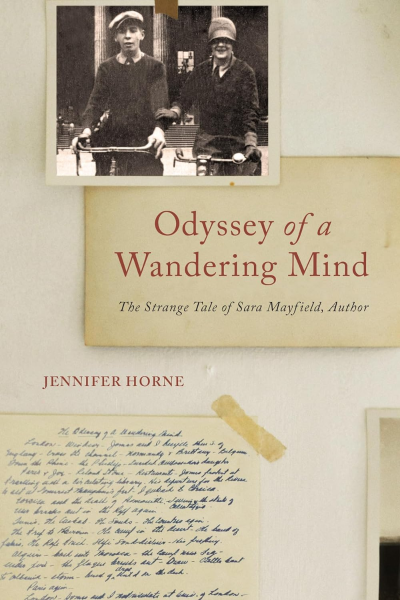Odyssey of a Wandering Mind: The Strange Tale of Sara Mayfield, Author
By Jennifer Horne
The University of Alabama Press; 2024
Hardcover: $120.00; Paperback and eBook: $34.95
Genre: Biography, History
Reviewed by Edward Journey
Sara Mayfield (1905-1979), an Alabama writer, journalist, and inventor, grew up in a privileged Southern family, forged a career in writing and reporting, and spent seventeen years in a state mental institution. After being released from the mental hospital, at age sixty, she hit the ground running and, in short order, published two widely reviewed biographical studies as well as a historical novel about Mona Lisa and Leonardo da Vinci.
In her excellent new biography, Odyssey of a Wandering Mind: The Strange Tale of Sara Mayfield, Author, Jennifer Horne, a writer, editor, teacher, and past Poet Laureate of Alabama, has meticulously researched and documented Mayfield’s fascinating life, clearly intending to do right by her subject. Fortunately for Horne, Mayfield kept a diary, starting at age five; the diaries, the letters Sara saved, and her voluminous papers are a part of the University of Alabama’s Special Collections. Horne uses these and other documents, clinical studies, and first-person accounts to create a probing portrait of a one-of-a-kind life.
Sara Mayfield was born in Tuscaloosa and her family had a house, Idlewyld, in town as well as farmland across the river. Her growing-up years were spent mostly in Montgomery as the daughter of a justice in the Supreme Court of Alabama. Among her close childhood friends in Montgomery were Tallulah Bankhead, Sara Haardt, and Zelda Sayre, each of whom later distinguished herself in arts and literature. In addition, Haardt married journalist and critic H. L. Mencken and Sayre married writer F. Scott Fitzgerald. From her earliest years, Sara Mayfield seems to have been in proximity to famous people and people destined for fame. Luminaries of the twentieth century frequently pop up in this account of Sara Mayfield’s life.
The Mayfield family was marginally progressive by the standards of the day but still held patrician attitudes toward class and race. The family also respected the tradition of the well-behaved “little lady,” a set of inflexible rules for proper behavior that Sara and her friends quietly rebelled against. At age sixteen, Sara seems to have been somewhat traumatized by the possible implication, made by a chaperone while on a school trip to Europe, that her relationship with a school friend might be sexual in nature. For the rest of her life, Sara seems at times to obsess over her attraction to women – even, at one point, attempting to create scientific principles to explain sexual attraction.
Sara had several engagements, a brief marriage, graduated from Goucher College where her friend Sara Haardt was a professor, entered graduate school at the University of Alabama, and traveled extensively. She experimented with something she called “synthetic chemistry,” focusing on experiments with cotton, cotton stalks, corn husks, and agrarian waste products. During the Great Depression, she started an “unemployment colony” on her family’s Tuscaloosa County farm. She moved around, dabbled in theatre, had a job with a distillery, worked with plastics, and freelanced as a reporter and writer in energetic spurts. Sara might have been encouraged to audition for the role of Scarlett in Gone with the Wind; her preference would have been to work on the script.
She wrote for various publications and made earnest attempts to become a well-informed reporter and foreign correspondent, traveling as a press correspondent to United Nations conferences in Mexico and San Francisco. While in San Francisco in 1945, she met future President John F. Kennedy. A friend commented that “She didn’t like him; he was, of course, a Yankee and a snob. She sort of pitted him in the same category as Scott Fitzgerald.” Sara was a first-hand witness to the dysfunction of her friend Zelda Sayre’s marriage to F. Scott Fitzgerald and, in contrast, to the strong bond of her friend Sara Haardt’s marriage to H.L. Mencken. When Sara Mencken died young, Sara Mayfield continued her warm friendship and correspondence with H.L. for the rest of his life.
Through much of her life, Sara Mayfield went through periods of mental stress and instability. She was prone to paranoia and at one point became increasingly concerned about Fascist conspiracies among high-ranking conspirators within the United States. After being tricked by her mother and brother into a brief “rest cure” at a Baltimore mental institution, Sara created a narrative spin asserting that it had to do with her alleged asset as an agent of military intelligence. Throughout her life, Sara Mayfield tried to put her spin on things that might lead to people thinking her “mad.”
By any measure, Sara Mayfield was a woman of accomplishment. Her accomplishments are made more impressive by the fact that much of what she accomplished took place while she was a patient at an understaffed and underfunded state mental facility, Bryce Hospital, in Tuscaloosa. Her admission to Bryce occurred at a time when it was relatively easy for family members to admit someone who might have become an “inconvenience.” Her confinement lasted from 1948 to 1965, during which she often remained remarkably lucid, observant, and productive. She was able to do research at the University libraries (they were within walking distance), travel, meet with friends, continue writing and experimenting, and cofound a hospital newspaper, the Bryce News. Sara accomplished the rare feat of getting a U.S. patent for a “dry plastic composition” in 1950 while she was a patient at Bryce. Despite the delusions and paranoia that put her there, Sara delivered calm and rational insights into the hospital conditions and her fellow patients and was emboldened to write with frankness in the in-house newspaper. Horne addresses Mayfield’s mental health challenges with sensitivity and a generous benefit of the doubt; at one point, she quotes Anne Rivers Siddons: “I have a theory that Southern madhouses are full of gifted women who were stifled.”
Upon leaving Bryce in 1965, after seventeen years, Sara Mayfield wrote a bio to a Baltimore correspondent stating that she had conducted “research in contemporary literature, 1948-1965.” After Bryce, she went full-throttle in her literary pursuits and was hired as an assistant editor at the University of Alabama Press. She published The Constant Circle: H.L Mencken and His Friends, her book about Sara and H.L. Mencken, in 1968. In 1971, Mayfield’s Exiles from Paradise was about Zelda and F. Scott Fitzgerald. One editor praised Mayfield for “trying to tell [Zelda’s] side of things,” but the book suffered from coming so soon after another biography of Zelda by Nancy Milford.
After Exiles from Paradise was published, Mayfield was urged to push ahead with her planned book about Tallulah Bankhead’s early years. She demurred, saying, “I need a respite from the twenties and the tragedies of my friends.” Instead, she turned to a project she had been working on for decades. Published in 1974, Mona Lisa: The Woman in the Portrait was a historical fiction biography of Lisa del Giocondo, the Renaissance-era subject of Leonardo da Vinci’s most famous painting.
Sara Mayfield, like so many of her friends and contemporaries, has largely been forgotten. With Odyssey of a Wandering Mind, we are fortunate that Jennifer Horne has documented the astonishing story of a life “fully felt and deeply experienced” with such grace and agility. Horne explores “where the gaps are, the quiet, shadowed places.”
Edward Journey, a retired university professor and theatre professional living in Birmingham, regularly shares his essays in the online journal “Professional Southerner” (www.professionalsoutherner.com).






